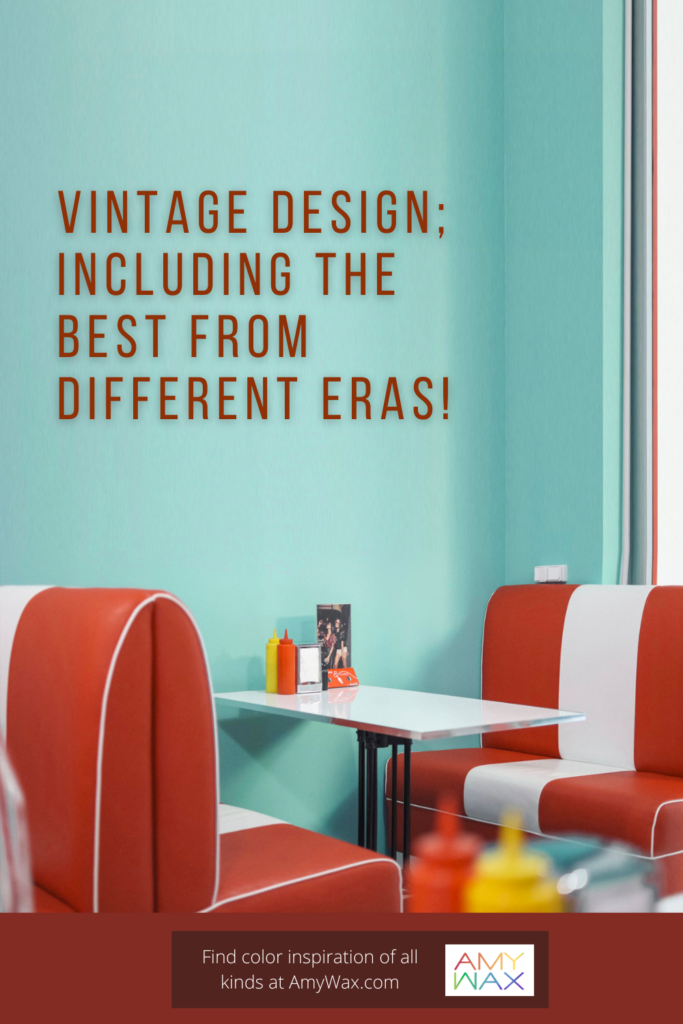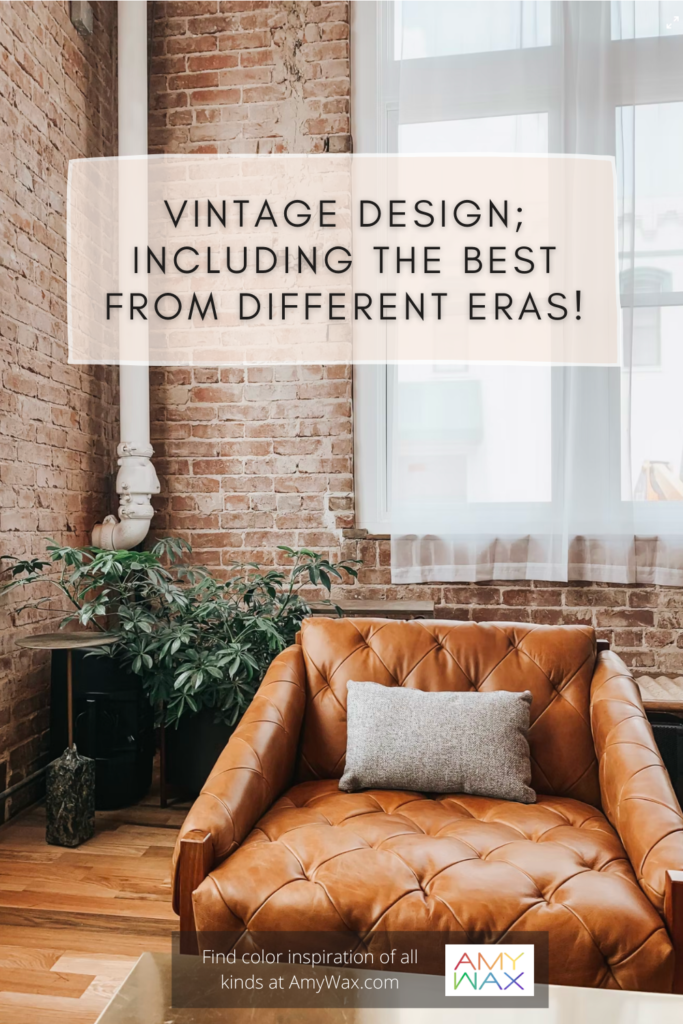We often hear terms but cannot define them with confidence. One term I frequently hear as a color expert is “vintage” or “vintage design.” You may hear someone say, “Oh, that piece is so vintage, I love it! Or, “let’s get some vintage pieces of furniture or art in this room” It might mean different things to different people, but what exactly does vintage mean, and how can you implore the design style in your home if you so choose? This article will explore the idea of vintage design, why it might be a design you should consider, and provide you with some tips on adding vintage styling to your home!
Vintage Design; What is It?
The Merriam-Webster dictionary defines the adjective vintage as: of old, recognized, and enduring interest, importance, or quality.
While this is somewhat broad, I do think it represents the essence of something that would be considered vintage. To me, vintage design means that not only is an item, collection of items, design scheme, or colors recognizable from a particular era, but they are in quality condition to represent that era proudly.
There is also a time element to vintage design; many designers, including myself, feel that for something to be considered vintage, it needs to be between 20-and 99 years old. Newer than that is contemporary, and older than that, I would consider antique design.
How much vintage are you obligated to include? Let’s start with one piece! As much as I am referring to creating a design that makes a complete statement, here’s another way to include vintage in your home. Imagine you have a home in luscious neutrals, creamy fabrics, furniture in natural colors such as grays and whites, possibly with black accents, all of your colors are understated and elegant. If the design is understated, you have the opportunity to include a large poster or piece of artwork that becomes the statement in the room. Whether it is a vintage poster, photograph, or piece of art, it is the conversation piece that brings vintage into your design and gets everyone talking!
Perhaps you love the style of a particular period, don’t be afraid to include a piece or set in that style. Let’s read more about the different periods and see what inspires you the most!
Learn About Beautiful Victorian Home Colors!
How To Arrange a Vintage Design Scheme
Now, truly creating a vintage design scheme in your home doesn’t mean you simply hang a clock from the 1960s on the wall and call it a day. That would be utilizing a unique accent piece, but it hardly creates a collaborative atmosphere in a vintage style. Designing for a vintage feel calls for a concerted effort to create an entire sphere representing an era with style and serious intent. What makes vintage pieces enticing is that they have a unique style and stand out in the room.
You don’t have to sacrifice modern appliances, furnishings, or design elements to complete a vintage feel to a space; however, they must work in harmony and complement each other. It would be quite demanding to ask that someone create a vintage kitchen with all original appliances from five decades ago. Still, the era must speak for itself when visitors walk in. If you are not designing the room to be solely a reflection of that period, then the vintage piece should complement the style of the rest of the room and be the conversation piece that everyone is talking about.
Spring is Here! What Are Your Exterior Paint Colors Saying About Your Home?
Vintage Design Examples to Incorporate into Your Home
As the concept of vintage design can be somewhat abstract, I’m going to provide you with some vintage design examples I love, and you can decide if you like to create some vintage vibes in your home!
- The 1930s-1940s Dream Study
I have a certain affinity for the vintage design scheme representing the 1930s and 1940s. I love the muted and pastel colors; the oranges, dusty browns, and light, airy blues work harmoniously with hints of bronzes and silvers streaking along as accent highlights. It’s such a wonderfully warm, vintage vibe. A great representation of this vintage era was captured in Martin Scorsese’s “The Aviator.”
Picture walking into a study with robin’s egg blue walls, light grey trim, wide-plank hardwood floors, and a mammoth-sized 1940s-era desk on one wall. A vintage desk lamp, radio, and even a bar set are all industrial silver. Art prints of the era adorn the walls, from Howard Hughes to King Kong, and the posters reinforce the representation of the era. How could you not love that vintage vibe!?
- Mid-Century Modern – Post World War II
The vintage style that is all the rage right now is Mid-Century Modern, or MCM as it is commonly referred to. A style that has a look all its own with rooms flooded with daylight and wooden furniture that is angular and delicate at the same time. The look is simple and understated; you will see furniture legs that are thin with curved stylized shapes throughout. This period has a distinct color palette of pale olives, slate blues, and dusty golds, highlighted with saturated colors such as oranges, reds, yellows, greens, and even bright teal blues. Mid-Century Modern is an iconic style I will be discussing in another blog post ( because there is so much to say about it!)
- The 1960s-1970s Lounge
Remember, a vintage design scheme represents different eras and decades of styling. If the result is successful, it should be no mystery to your guests which era they are walking into. If a homeowner wants to immerse their guests in a 1960s-1970s vintage design, a lounge room or even basement is a great place to create that experience.
Imagine walking down into a basement/lounge adorned with dark oranges, rich olive greens, and funky patterned wallpaper. The furniture is tufted brown leather, showing years of good use! The bar has vintage bar stools and lounge chairs that could only come from the 1960s/70s – it’s like being in a lounge with oversized seating and earthy colors that are so inviting that you never want to leave!
Vintage Design – Is it For You?
So what do you think about vintage design? Is the concept any clearer for you? Is it something you would consider in your home? There’s no way around it; going for a vintage design in any area of your home takes savvy curation and commitment. You cannot capture a vintage vibe by being half-committed. Please, let me know if you have any vintage design elements in your home!
Check out my accompanying piece on Retro Colors, it is so much fun to read, and it digs a little deeper in all the right ways 🙂






This is such an informative post, Amy. Thanks for the education and all of the great ideas!
Thanks so much Leslie, I’m so glad you found this weeks blog post both informative and inspiring!
Love the explanation of vintage and the definitions of different eras. I am setting up my daughter’s new apartment and vintage is a great approach for her budget!
Yes thats a great idea Lisa, and it’s a fun way of making the design of a space personal as well!
Love the addition of vintage pieces to add fun style to a space. And totally agree with your definition of “vintage”, though it’s a little scary to realize that the 70’s 80’s and 90’s now all fall into the vintage category! Eek, I’m old! 🤣
I love your comment Janet, I would have rewritten the definition if I had the opportunity to do so!
I love shopping for vintage finds! It makes a space so much more interesting.
Yes you are absolutely right Christie, it also adds a personal touch to every decor!
Love this walk through time Amy!
Thanks Linda, and I love your description of it 🙂
I love spaces that have a vintage piece or two! Beautiful images and inspiration.
Thanks so much Carla, I’m so glad you found this weeks blog post inspiring!